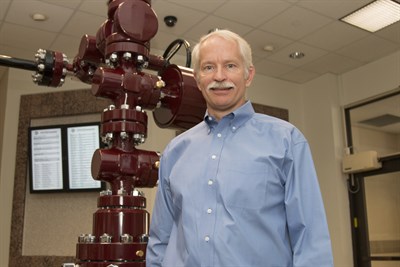 Dave Lucas, a veteran of the oil and gas industry, has been appointed as a subsea professor of practice and director of the subsea engineering program in the Dwight Look College of Engineering at Texas A&M.
Dave Lucas, a veteran of the oil and gas industry, has been appointed as a subsea professor of practice and director of the subsea engineering program in the Dwight Look College of Engineering at Texas A&M.
Lucas, who spent more than 35 years working for ExxonMobil, was enjoying retirement, but when the Look College came calling with the offer to serve as director of its newly established subsea engineering program, it was an interesting opportunity he couldn’t pass up.
“A place like A&M with the resources and support it has, that was a big selling point,” Lucas said. “The extensive research capabilities at Texas A&M, the high quality faculty and student population, combined with numerous ocean related programs and initiatives, all create a unique opportunity to provide leadership in the subsea field”.
Lucas’ hiring was the first step in making Texas A&M just the second university in the United States to offer the discipline. The University of Houston offers subsea engineering and there are only a handful of universities worldwide offering subsea engineering programs.
Lucas stated that the plan is for Texas A&M to offer a master’s degree, certificate and minor with the first subsea class offered in Spring 2015, with additional classes rolled out in Fall 2015 and the semester following.
“Already we’ve had a lot of interest ” Lucas said, “and for this to be most successful, we’ll need a lot of industry support for lecturers to present a wide variety of subsea technology topics, especially lessons learned and transfer of practical knowledge gained from experience. There are also plans for more subsea professors of practice.”
The field of subsea engineering deals with the design, fabrication, installation and operation of subsea equipment needed to produce oil and gas fields in underwater locations.
Subsea engineering is an emerging field, but the availability of training for individuals is limited.
“It has been talked about for a while,” Lucas said of subsea programs. “But only recently has there been a concerted effort at the university level.”
While subsea engineering programs are somewhat uncommon, subsea wells are not. As the easier-to-access offshore locations are depleted, companies continue to push the water depth limits to drill deepwater exploratory wells. And there is a high demand for subsea engineers needed to design and build the equipment needed to produce resources that are discovered.
Experts have said that deep-water locations can produce significantly more barrels of oil per day than conventional shale boom wells, but the challenges to extract that oil are greater because of the hostile environments encountered at such depths.
Environmental conditions presented by increasing water depths, longer distances from shore and difficult reservoir conditions create major challenges when designing reliable underwater equipment, and that is where the field of subsea engineering and the need for qualified individuals in the discipline comes into play.
“It’s extremely difficult to deal with the challenges that come with engineering design and operations in extreme environments,” said Dr. M. Katherine Banks, vice chancellor and dean of engineering at Texas A&M. “Under Dave’s leadership, we will make a significant impact upon preparing the next generation of engineers in this important area.”